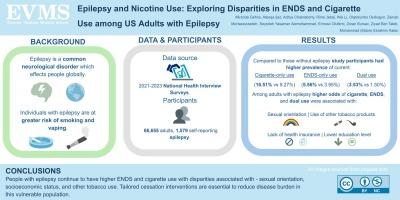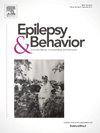癫痫和尼古丁使用:探索美国成人癫痫患者ENDS和香烟使用的差异
IF 2.3
3区 医学
Q2 BEHAVIORAL SCIENCES
引用次数: 0
摘要
癫痫患者使用烟草的风险更大,这可能加剧他们的健康挑战。本研究调查了美国成人癫痫患者和非癫痫患者中电子尼古丁传递系统(ENDS)、香烟和双重使用的患病率和社会人口学相关性。方法分析来自2021-2023年全国健康访谈调查的数据(N = 86,655名年龄≥18岁的成年人),其中包括1,579名(1.89%,约1450万美国成年人)自我报告癫痫(结果变量)。参与者被分为两个相互排斥的组:从不使用任何一种产品[参照组],目前(几天或每天使用)只使用香烟,只使用ends,两用,以前只使用香烟,以前只使用ends,以前两用。加权逻辑回归模型评估癫痫和烟草使用之间的关系,并根据社会人口统计学特征进行调整。结果癫痫成人仅吸烟(16.51% vs. 9.27%)、仅使用ends (5.56% vs. 3.95%)和双重使用(3.53% vs. 1.50%)的比例高于非癫痫患者。相对于从不吸烟,目前仅吸烟(AOR = 1.66, 95% CI: 1.36-2.01)、目前仅吸烟(AOR = 1.51, 95% CI: 1.08-2.13)和目前双重吸烟(AOR = 2.29, 95% CI: 1.56-3.48)在调整人口统计学和健康因素后与较高的癫痫发生率相关。在患有癫痫的成年人中,与异性恋者相比,男同性恋、女同性恋或双性恋者吸烟、使用ENDS或双重用途的几率更高。受教育程度较低的人吸烟的几率较高,而拥有医疗保险的人患癫痫的几率较低。与年轻年龄组相比,35岁以上的成年人吸烟的可能性更大,使用ENDS的可能性更小。结论癫痫患者的香烟、ENDS和双重使用率高于非癫痫患者。性取向、教育和保险状况等社会因素进一步影响这一人群的烟草使用。有必要为这一弱势群体量身定制戒烟干预措施,以减轻疾病负担。本文章由计算机程序翻译,如有差异,请以英文原文为准。

Epilepsy and nicotine use: Exploring disparities in ENDS and cigarette use among US adults with epilepsy
Introduction
Individuals with epilepsy are at greater risk for tobacco use, which may exacerbate their health challenges. This study examines the prevalence and sociodemographic correlates of electronic nicotine delivery systems (ENDS), cigarette, and dual use among US adults with and without epilepsy.
Methods
Data from the 2021–2023 National Health Interview Surveys were analyzed (N = 86,655 adults aged ≥ 18 years), including 1,579 (1.89 %, estimated 14.5 million US adults) with self-reported epilepsy (outcome variable). Participants were categorized into mutually exclusive groups: never-use of either product [reference group], current (used on some days or daily) cigarette-only use, ENDS-only, dual-use, former cigarette-only, former ENDS-only, and former dual-use. Weighted logistic regression models assessed the relationship between epilepsy and tobacco use, adjusting for sociodemographic characteristics.
Results
Adults with epilepsy had higher rates of cigarette-only (16.51 % vs. 9.27 %), ENDS-only (5.56 % vs. 3.95 %), and dual use (3.53 % vs. 1.50 %) compared to those without epilepsy. Relative to never use, current cigarette-only use (AOR = 1.66, 95 %CI: 1.36–2.01), current ENDS-only use (AOR = 1.51, 95 %CI: 1.08–2.13), and current dual use (AOR = 2.29, 95 % CI: 1.56–3.48) were associated with higher odds of epilepsy after adjusting for demographic and health factors. Among adults with epilepsy, identifying as gay, lesbian, or bisexual was linked to higher odds of cigarette, ENDS, or dual use compared to straight individuals. Lower levels of education were associated with higher odds of cigarette smoking, while having health insurance was associated with lower odds among adults with epilepsy. Adults ≥ 35 were more likely to smoke cigarettes and less likely to use ENDS compared to younger age groups.
Conclusion
Cigarette, ENDS, and dual use rates were higher in adults with epilepsy than in those without epilepsy. Social factors like sexual orientation, education, and insurance status further influence tobacco use within this population. Tailored cessation interventions are warranted for this vulnerable population to reduce disease burden.
求助全文
通过发布文献求助,成功后即可免费获取论文全文。
去求助
来源期刊

Epilepsy & Behavior
医学-行为科学
CiteScore
5.40
自引率
15.40%
发文量
385
审稿时长
43 days
期刊介绍:
Epilepsy & Behavior is the fastest-growing international journal uniquely devoted to the rapid dissemination of the most current information available on the behavioral aspects of seizures and epilepsy.
Epilepsy & Behavior presents original peer-reviewed articles based on laboratory and clinical research. Topics are drawn from a variety of fields, including clinical neurology, neurosurgery, neuropsychiatry, neuropsychology, neurophysiology, neuropharmacology, and neuroimaging.
From September 2012 Epilepsy & Behavior stopped accepting Case Reports for publication in the journal. From this date authors who submit to Epilepsy & Behavior will be offered a transfer or asked to resubmit their Case Reports to its new sister journal, Epilepsy & Behavior Case Reports.
 求助内容:
求助内容: 应助结果提醒方式:
应助结果提醒方式:


